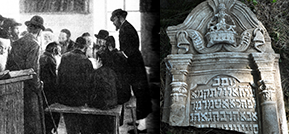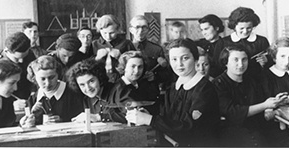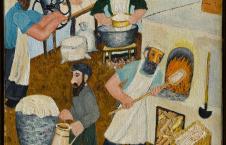Shoshana Eden painted her shtetl childhood memories . The shtetl is shown from a young girl's point of view, and therefore the paintings offer a unique look at a world destroyed by the Holocaust
click to see the entire collection
Shoshana Eden was born in Poland in 1917 to Malka and Mendl Feurstein. Her family was deported from their shtetl along with the rest of the Jewish community during the battles of the First World War. Shoshana Eden was born in Borshchov, where her parents stayed as refugees.
After the war the family returned home to Skała (a shtetl in Galicia, near Tarnopol: then in Poland, nowadays in the Ukraine). On arrival they found that their home and the family business
were looted during their absence. That fate was shared by most of the returning refugees, and the community sunk into deep poverty.
Shoshana Eden's mother died when she was eight years old. Her main solace was studying. She attended both the state Polish school and the Hebrew school "Tarbut". There was no high school in Skala and her impoverished father couldn't afford to send her away to
school. To her great disappointment she had to make do with books from the lending library.
Shoshana Eden was a Zionist and a socialist and when she turned eighteen, in 1935, she
made Aliyah and arrived in Palestine. She loved children and worked with children in Ben Shemen youth village and later in Jerusalem.
Shoshana Eden married her fellow townsman from Skała, Zvi Bilgoray, in 1940. Their families in Poland received the news about their marriage, and sent their congratulations. Shortly afterwards the Germans occupied the Lvov area and contact with home and family was severed, forever. Nearly all her relatives were murdered in the Holocaust.
Shoshana and Zvi lived in Haifa, Israel. He worked as an electrician while she raised their daughters. In 1971 their younger daughter, Hannah'le, died of cancer. The family convinced the grief stricken Shoshana to take painting lessons and painting became a focal point in her life.
Under the painter Gitit Harel's guidance Shoshana Eden found her medium - small scale naive paintings, and her subject - her childhood memories.
The paintings show the shtetl from a young girl's point of view, and therefore concentrate on family life and the community's everyday life, as she experienced them. All the persons
depicted were her childhood neighbours. She felt she was creating a memorial to them, as most of them were murdered in the Holocaust. The paintings also show Gentile figures, but they are few, and always minor charachters, which reflects the way the painter experienced their place in the Hassidic community's life.
In the early 1980s she felt that her eyesight was failing. Aspiring for perfection as always, she stopped painting. An exhibition of her work was held in 1996 in the Mane Katz museum in Haifa.
Shoshana Eden died in 2002
Shoshana Eden painted her shtetl childhood memories . The shtetl is shown from a young girl's point of view, and therefore the paintings offer a unique look at a world destroyed by the Holocaust
click to see the entire collection
Shoshana Eden was born in Poland in 1917 to Malka and Mendl Feurstein. Her family was deported from their shtetl along with the rest of the Jewish community during the battles of the First World War. Shoshana Eden was born in Borshchov, where her parents stayed as refugees.
After the war the family returned home to Skała (a shtetl in Galicia, near Tarnopol: then in Poland, nowadays in the Ukraine). On arrival they found that their home and the family business
were looted during their absence. That fate was shared by most of the returning refugees, and the community sunk into deep poverty.
Shoshana Eden's mother died when she was eight years old. Her main solace was studying. She attended both the state Polish school and the Hebrew school "Tarbut". There was no high school in Skala and her impoverished father couldn't afford to send her away to
school. To her great disappointment she had to make do with books from the lending library.
Shoshana Eden was a Zionist and a socialist and when she turned eighteen, in 1935, she
made Aliyah and arrived in Palestine. She loved children and worked with children in Ben Shemen youth village and later in Jerusalem.
Shoshana Eden married her fellow townsman from Skała, Zvi Bilgoray, in 1940. Their families in Poland received the news about their marriage, and sent their congratulations. Shortly afterwards the Germans occupied the Lvov area and contact with home and family was severed, forever. Nearly all her relatives were murdered in the Holocaust.
Shoshana and Zvi lived in Haifa, Israel. He worked as an electrician while she raised their daughters. In 1971 their younger daughter, Hannah'le, died of cancer. The family convinced the grief stricken Shoshana to take painting lessons and painting became a focal point in her life.
Under the painter Gitit Harel's guidance Shoshana Eden found her medium - small scale naive paintings, and her subject - her childhood memories.
The paintings show the shtetl from a young girl's point of view, and therefore concentrate on family life and the community's everyday life, as she experienced them. All the persons
depicted were her childhood neighbours. She felt she was creating a memorial to them, as most of them were murdered in the Holocaust. The paintings also show Gentile figures, but they are few, and always minor charachters, which reflects the way the painter experienced their place in the Hassidic community's life.
In the early 1980s she felt that her eyesight was failing. Aspiring for perfection as always, she stopped painting. An exhibition of her work was held in 1996 in the Mane Katz museum in Haifa.
Shoshana Eden died in 2002







